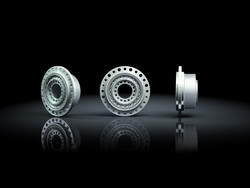Solid lubricants for space gear
The aerospace industry is demanding power transmission mechanisms that can work in temperatures as low as -173 degrees Celsius. The signal-to-noise ratio of sensors increases as temperature decreases. Such cryogenic environments can ensure precise measurements such as those required in far-infrared spectroscopy. Today, Harmonic Drive® gears provide high stiffness and high precision even at very low speeds but their use is limited by the need for grease or oil lubrication. Researchers working on the EU-funded project HARMLES (Dry lubricated Harmonic Drives for space applications) explored the use of solid lubricants to widen their usage from -170 degrees Celsius up to 300 degrees Celsius. Due to the low pressure and temperature in space, liquid lubricants incur the risk of outgassing and evaporation. This leads to loss of lubrication efficiency as well as outgassed products deposited on the sensitive surface of optical components. For gears with high demands, thin film coatings based on molybdenum disulphide (MoS2) is an attractive alternative. HARMLES researchers developed an advanced coating based on MoS2. This is a composite coating consisting of a tungsten carbide-interlayer plus a solid lubricant top-layer of reinforced MoS2. To validate its tribological behaviour, extensive tests were conducted. These included pin-on-disc and fretting tests that were benchmarked against the performance of various coating types based on diamond-like carbon, among others. HARMLES set out to re-design Harmonic Drive® gears based on the results of finite element analysis and numerical simulations of the gears' kinematics. Potential design changes were elaborated taking into account the capabilities of dry lubrication. HARMLES enabled within its duration to increase the achievable endurance of the gears by a factor of 20, whereas the characteristics of the prototypes were in line with the requirements defined by the space industry: At 4Nm lifetimes of even up to 20.000 output revolutions were achieved in vacuum testing (partly even without failure at end of test, compared to a few hundred at the beginning of the project). In contrast to grease lubricated HDs, the efficiency course of the gear during the vacuum endurance test was almost stable throughout the whole test. HARMLES will strengthen the competitiveness of European space industry, which is already interested in this development. Following several publications, requests by companies increased already. Nevertheless, further improvements are seen as feasible. Spin-offs into high vacuum applications in the semiconductor industry and the cryogenic environment in large testing facilities like the Deutsches Elektronen-Synchrotron (DESY) are expected to follow.
Keywords
Solid lubricants, Harmonic Drive® gear, power transmission, cryogenic environment, molybdenum disulphide, finite element analysis, tribology, friction and wear



